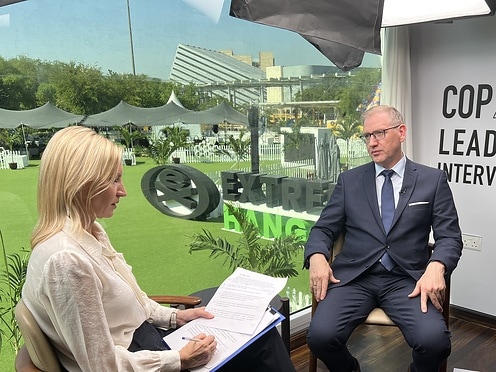How farmers adapt to climate change
Heat waves, droughts, storms – climate change is having an increasing impact on agricultural production. Farmers have to find new ways of avoiding crop failures and securing food supplies. This requires cooperation on a global scale: Countries in the Global South can benefit from industrialised nations in the West and vice versa.
This text is part of Wilo's annual report 2022.

Climate change threatens agriculture: Sub-Saharan Africa faces 50 per cent crop losses
The agricultural sector is of fundamental importance for Burkina Faso’s economy. The landlocked country in West Africa generates around a third of its gross domestic product from agriculture. 80 per cent of the population grows fruit, vegetables and cereals to supply themselves with food. This is becoming harder and harder: Increasingly unpredictable rainy periods, rising temperatures and extreme precipitation often lead to crop failures. According to forecasts, this could mean losses of up to 50 per cent in Burkina Faso and other countries in sub-Saharan Africa.
Farming in the age of climate change: adapting to new conditions
The example of Burkina Faso shows how climate change impacts agriculture. According to the Intergovernmental Panel on Climate Change (IPCC), global warming has already reduced crop yields in some parts of the world. And the situation could get worse. According to the IPCC, if temperatures rise by three degrees or more, it will no longer be possible for agriculture to adapt to the new conditions in the immediate proximity of the equator. That’s why it’s already happening today. In Burkina Faso, a programme was launched together with the German Federal Ministry of Education and Research with two goals in mind. Firstly, it aims to better record and predict precipitation amounts in order to create more planning security. Secondly, it is installing a novel rainwater storage system to use rainwater for additional irrigation as required.
High temperatures have high costs
The consequences of climate change are clearly felt in Germany too. They manifest themselves in heavy rainfall, temperatures exceeding 40 degrees, long dry periods and sudden storms. 14 of the 20 hottest years since records began have been in the last 20 years. This also has a clear impact on agricultural production: According to a recent study by the research institute Prognos, heat and drought resulted in damages of more than 25 billion euros in 2018 and 2019 alone, 4.4 billion euros of which was due to yield losses in agriculture.
Wheat and rapeseed benefit whilst maize and beets suffer
This picture is also reflected in the annual harvest report published by the Federal Ministry of Food and Agriculture, albeit in different ways. Winter crops such as wheat or rapeseed, which are harvested early, produced unexpectedly good harvests last year. However, crops that are cultivated later such as maize and sugar beet suffered greatly as a result of the dry summer. It is therefore also becoming increasingly important for German farmers to adapt in order to secure food supplies in the long term. According to the harvest report, one of the most successful strategies is sustainable agriculture with a high level of biodiversity and diverse crop rotations.
Sustainable crop rotation thanks to chickpeas and lupins
This has already been successfully implemented by farmers in recent years. For example, chickpeas, lupins or sweet potatoes can increasingly be found in fields in Germany – all plants that thrive well even in higher temperatures and without much water. The federal government supports approaches like this with the protein crop strategy. It offers incentives for farmers to grow more pulses in addition to cereals and oilseeds. In doing so, it aims to promote biodiversity and increase the protein supply from domestic production. Soybeans are also increasingly suitable for cultivation in European fields. The Leibniz Centre for Agricultural Landscape Research in Müncheberg in the state of Brandenburg recently conducted a study on this. The main finding was that with soybeans, farmers can not only expand their crop rotation, but also help reduce imports from Brazil and the USA – a further step towards sustainable agriculture.

Compensation for the impacts of climate change in developing countries
Germany can rely on enough money, specialist knowledge and technology to adapt its agriculture to new conditions. However, many countries do not have these resources, especially emerging markets and developing countries. Although they themselves emit very little carbon dioxide, they are often particularly affected by climate change. The global community came together last year at the UN Climate Change Conference in Sharm El Sheikh in Egypt to discuss this imbalance. They managed to reach an agreement: The countries of the Global South are to receive funding to offset the damage caused by climate change.
International fund promotes adaptation measures
How exactly this funding is to be used is still open to negotiation. But even today, industrialised countries are financially supporting emerging and developing countries in adapting their agriculture to the new conditions in the long term. To this end, the United Nations has set up the International Fund for Agricultural Development (IFAD). Amongst other beneficiaries, it helps small farmers in developing countries better prepare for the consequences of climate change. Money from the fund has, for example, helped cocoa and coffee farmers in Papua New Guinea better network with their customers and the agricultural industry and build up knowledge on sustainable agriculture. As a result, cocoa and coffee sales increased by 82 per cent.
West-African ingenuity
Many emerging and developing countries have also long since developed their own adaptation methods for securing food supplies. After all, they have had to deal with issues such as droughts and extreme weather events for much longer than industrialised nations in the West. In Burkina Faso, for example, farmers use what is known as the Zaï technique to restore dry soils and increase their fertility. To do this, they dig small pits with a digging stick and fill them with organic material. The farmer Yacouba Sawadogo developed the method further and greened an entire area of land in this way. This earnt him the Right Livelihood Award in 2018, also known as the “alternative Nobel prize”. In view of climate change, such methods are also gaining traction with European agronomists. This shows that not only is climate change a global issue for agriculture – so are good ideas on how to adapt to the new conditions.
Summary: Climate change requires sustainable agriculture
Climate change is leading to poor harvests in agriculture, thus jeopardising food security. These consequences will worsen in the coming years. Farmers from across the world must therefore adapt their production methods to the new conditions in the long term. In Germany, for example, we can see this through additional, particularly heat-resistant crops such as pulses being integrated into the crop rotation. The world is also working together across borders to safeguard food supplies in the future. Industrialised countries are supporting developing countries with technology, knowledge and money. Countries in the Global South have long since been afflicted by the problem and have developed their own solutions – from which industrialised nations can also learn something.


















